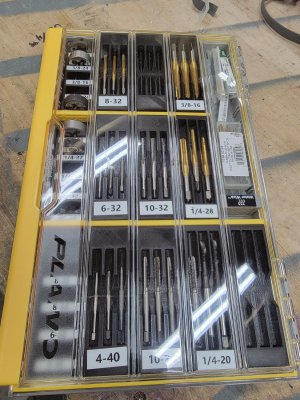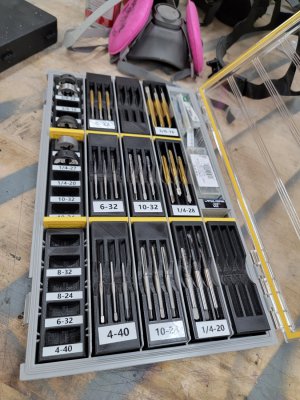Having several "hobbies", I have several storage systems, each more or less appropriate to what I am working with at any given time. For framing carpentry, including roofing with steel sheets, there are dozens of Nr 10 cans (large coffee cans) full of nails and screws. My model trains have small drawers for train parts, and many fishing tackle boxes. Electronics parts have parts bins specific to circuit board parts, and electrical parts are in cardboard boxes, mostly on shelves in the barn. With all those storage systems, functional as to size and usage, I am still covered up with miscellaneous boxes along side my desk in the house. And no workbench space because every inch is covered up with "stuff" that I consider worth keeping.
I have been increasing work/storage space for 40-50 years, trebling my shop space and quadrupling my storage needs in the shop spaces. It seems that as I increase shop space by 10%, I increase storage needs by 20-25%. That seems to be the nature of anyone (most?) in the mechanical trades as a hobby. All the more so, a known trait of model railroaders. And more still for electronics hobbyists. Collecting those little bits and pieces that are becomming more and more difficult to locate as the supply chain draws in and technology grows more advanced. Had I but known then. . .
In my specific case, I desire to build a "fast time clock" for my trains. One that clicks off an hour in 20 minutes. The models are to scale, what about scale time. 25 years back, an assembled digital clock could be modified with just a handfull of common components to speed up the clock reference. Today, the clocks are accurate to a microsecond (thanks China) but the reference pulses run so fast and are so difficult to get to that circuit board changes are no longer practicable.
A similar change has taken place in the machining hobby. Many years back, I modified some of my machine tools to use NC (numerical control) systems. Analog servos, analog resolvers, and the appropriate electronics. I eventually removed them, part of the hobby of machining is making mistakes. When I make a mistake, it's lesson learned. When the machine makes a mistake, it's time for a redesign. Then along comes CNC (Computer Numerical Control) that costs 10 times as much but doesn't make 1/10 as many mistakes. Most of my work as a hobbyist is "one off" parts. It may be accurate to 1/64 inch (~.015) or to a 1:10K(.0001), whatever is appropriate for what I am working on. It takes a week, as often as not, to get the computer system worked out to make that one part. Or I just make one in an hour or two by hand and then go on. So I don't have a CNC system. . .
No more rant, I digressed too much.
.

 www.hobby-machinist.com
www.hobby-machinist.com



